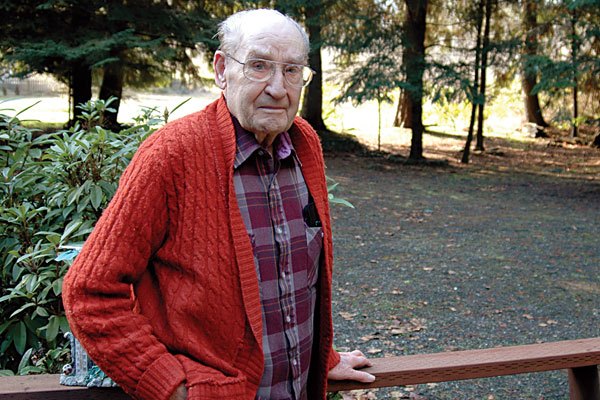by MATTHEW NASH
Sequim Gazette
Walter “Wally†Zergman took a long look back before he celebrated his 90th birthday.
At the prompting of his nephew Bill Scott, Zergman met with the Sequim Gazette to discuss his 68-year-old prisoner-of-war story before dining at 7 Cedars Casino.
Although he is a survivor of the Bataan Death March, Zergman says, at this stage of his life, he thinks more about what’s going on in Sequim and his golf game than the worst experience he’s lived through.
Zergman said, though, people should know what happened back then.
For more than three years during World War II, he was a prisoner of war in the Philippines and Japan after the United States surrendered more than 75,000 American and Filipino soldiers to the Japanese at the Battle of Bataan. It remains one of the largest American surrenders in any battle or war.
Zergman says we all need to remember our victories and defeats.
“It’s all part of history.â€
Fight on
Zergman, now a retired Navy chief petty officer, was fighting in foxholes on Corregidor Island in the Philippines.
Gen. Douglas MacArthur was leading the Battle of Bataan before President Franklin Roosevelt replaced him with Gen. Jonathan Wainwright. Gen. Edward King led troops north of the island who surrendered on April 1942, one month prior to Wainwright’s surrender. King’s troops — including Zergman — were out of contact.
“Wave after wave would hit. We’d fight back but all our guns got knocked out,†Zergman said.
After Corregidor Island put up the white flag, Zergman was one of more than 12,000 American and 60,000 Filipino soldiers forced to walk with little or no food through hot, dense jungle to Bataan in what became known as the Bataan Death March.
Fall or survive
Zergman’s was one of the last Allied forces groups led north by Japanese soldiers along the western coast of Manilla Bay to Camp O’Donnell, a temporary prison camp.
“We were all sick from malaria.
“If you couldn’t keep up, they’d beat you or bayonet you.â€
He watched his fellow soldiers die.
The camp eventually was shut down, and Zergman and others were crammed into standing-room-only storage below deck on what the POWs dubbed “hell ships†and transported to Camp 17 in Sasebo, a small village outside of Fukuoka, in southwestern Japan.
There he was forced to labor in a coal mine a half-mile below ground.
Thin chances
At the camp, Zergman was so malnourished he weighed 68 pounds, he said.
“I knew I didn’t have much longer.â€
As a last resort, to increase his chances of survival, Zergman had a colleague break his arm with a jackhammer bit so he would be reassigned from the coal mines to a rock pile, chipping mortared brick for reuse.
The work was less physically draining, but harder emotionally. Six to 10 people died each night, and those on the rock pile had to burn the dead and spread their ashes in the ocean.
To build up his weight, Zergman tore the assigned daily meal numbers off the dead prisoners’ clothes and went through the meal line two or three times a day. He got his weight up to 92 pounds.
Bombings
At the Aug. 9, 1945, atomic bombing of nearby Nagasaki, Zergman said the Japanese soldiers were startled by the bright light and ran for the jungle, leaving the mines unguarded.
Days later, American planes dropped literature saying the war was over.
Zergman and friends left and walked into bombed Nagasaki but turned around.
Eventually rescue groups transferred Zergman to Pearl Harbor, Hawaii, and then home to California.
Three years and three months later after the surrender, he was free.
Life in the U.S.
He married June Scott later that year and they had two children.
They’d been engaged at Pearl Harbor before his stationing in Manilla. He didn’t anticipate her waiting for him.
Zergman retired from the Navy in 1959 after 20 years of service, and then years later as an electro-optician from TRW in Calif.
He and June moved to Sequim in 1980.
Memories
Zergman said he remembers the whole experience clearly and he learned a lot about himself afterward.
“It made me appreciate the good life more.â€
Zergman’s nephew said many survivors and military personnel avoid discussing the march but, after moving to Sequim, Zergman was given the opportunity to speak to students about his experience.
He said they asked good questions, but he is disappointed that people don’t know more about the Bataan Death March.
“People have heard of it but they don’t know much about it.
“It should have been in the history books (in more detail), but for some reason it’s not so much.â€
He and other peninsula veterans and POWs used to have reunions but most have died, so the groups were disbanded.
Today, Zergman says he plays life looser and takes chances. He said his golf game has stayed about the same for 30 years and playing at the casino won him $20.
What’s next?
He’s celebrating his life and hoping people remember his story.
Reach Matthew Nash at mnash@sequimgazette.com.



